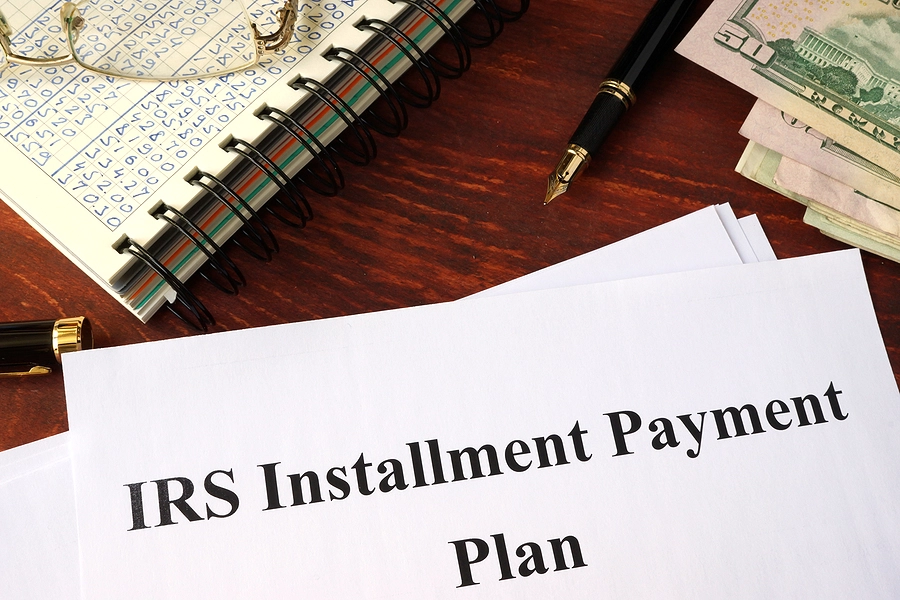IRS Payment Plan

Owing taxes to the Internal Revenue Service (IRS) is a frightening situation to find yourself in, but IRS payment plans offer a viable solution. IRS payment plans, also known as installment agreements, allow taxpayers to repay their tax debt over time in manageable, monthly payments.
This approach can significantly ease the burden for individuals struggling with combined tax penalties and interest who may find it difficult to pay their taxes in full by the due date.
What Is an IRS Payment Plan or Installment Agreement?
An IRS payment plan is an agreement between a taxpayer and the IRS that allows the taxpayer to pay their tax debt in monthly installments over an extended period. An installment agreement allows individuals who cannot afford to pay their tax bill in full to make smaller, monthly payments towards their tax debt.
There are two types of IRS payment plans – short-term and long-term payment plans. A short -term payment plan, or short-term IRS payment plan, allows taxpayers to pay off their tax debt in 180 days or less. On the other hand, a long-term payment plan, also known as an installment agreement, provides taxpayers with more time to pay off their tax debt.
The type of payment plan you qualify for is determined by the IRS based on several factors, including your outstanding tax debt, your ability to pay, and your financial circumstances. The IRS payment plans are designed to help taxpayers avoid costly tax penalties and interest that can accrue over time if the tax debt is not paid.
Are There Fees for IRS Payment Plans?
There are fees associated with setting up an IRS payment plan. The setup fee varies depending on the type of payment plan and the method you use to apply for the plan. The IRS offers help here for low-income taxpayers who qualify.
For instance, if you apply online for a long-term payment plan, the setup fee in 2023 is $31 if apply online. This setup fee increases to $107 for non-direct debit payments or applications made via phone, mail, or in person. For short-term payment plans, there are no setup fees for individuals.
However, keep in mind that these fees do not eliminate interest and penalties.
Interest Rate Without an Installment Agreement When You Don’t File on Time
If you fail to pay your taxes on time and do not enter into an installment agreement, the IRS will assess penalties and interest on your outstanding tax bill. There are also late payment penalties for each month that the tax is not paid in full, up to a maximum of 25% of your total debt.
It is also crucial to note that, even with an installment agreement, the IRS continues to charge interest until the entire balance is paid in full. However, entering into a payment plan allows for the penalty rate to be reduced.
Short-Term Payment Plan Fees (180 Days or Less)
For short-term payment plans, also known as a short-term IRS payment plan, the IRS does not charge a setup fee. This type of payment plan allows taxpayers to pay off their tax bill in 180 days or less. Although there is no setup fee for these plans, interest and any penalties will continue to accrue until the balance is paid in full.
While there are no setup fees for short term payment plans, it is essential to be aware of the potential costs associated with different payment methods.
For example, while payments directly from a checking or savings account (direct debit) or via check, money order, or debit card do not incur additional costs, credit card payments will have a processing fee imposed by the payment processor, not the IRS.
Long-Term Payment Plan (Installment Agreement)
For taxpayers unable to pay off their tax bill within 180 days, a long term payment plan or installment agreement is an option. However, these agreements come with a setup fee, which varies based on how the agreement is established and the mode of payment.
If you apply online and agree to make automatic withdrawals, the setup fee is $31. For online applications without automatic withdrawals, the fee is $149.
For those who apply for a payment plan by phone, mail, or in person, the setup fee is $107 for automatic withdrawals and $225 for other payment methods. For low-income taxpayers, these fees may be refunded, providing some financial relief.
Like short-term payment plans, penalties and interest continue to accrue until the tax debt is paid in full, even with an installment agreement in place. Therefore, it’s beneficial to pay off your tax debt as quickly as possible to minimize these additional costs.
Minimum Monthly Payments for IRS Installment Plans
The minimum monthly payment for an IRS installment plan is generally based on the total amount of your tax debt divided by 72, though you will be asked how much you can pay.
However, the IRS will consider your specific circumstances, such as your ability to pay and your living expenses, when determining your monthly payment amount. It is also possible to pay more than the minimum monthly payment, which will help to pay off the tax debt faster and reduce the total amount of interest paid.
Why Do I Have to Pay a Setup Fee?
The setup fee for an IRS payment plan covers the administrative costs associated with establishing and managing the installment agreement. These costs might include processing your application, maintaining your account, and handling your payments.
It’s important to remember that the setup fee is not part of your tax debt. It is a separate fee that the IRS charges to cover its administrative costs. The fee is due when you establish your payment plan, and it is in addition to your regular monthly payments.
The setup fee is lower if you apply for your payment plan online and choose to make your payments via direct debit from your bank account.
Despite the setup fee and other potential costs, an IRS payment plan can still be a helpful tool if you’re unable to pay your taxes in full by the deadline. By allowing you to make smaller, more manageable payments over time, an installment agreement can help you avoid additional penalties and interest and reduce your overall tax liability.
Applying for an IRS Payment Plan Online
To apply for an IRS payment plan online, you can use the Online Payment Agreement tool on the IRS website. You’ll need to provide some personal information, such as your Social Security number or individual tax ID number, your filing status, and the mailing address from your latest tax return.
You’ll also need to provide information about your tax bill, including the type of tax you owe, the tax form used, and the tax year for which you owe.
However, if you prefer not to use the online application, need to set up a more complicated payment arrangement, or want to be sure that you’re not missing something crucial and are getting the best deal from the IRS payment plan possible, it’s essential to work with experienced tax lawyers who can cut through the jargon, present all your options, and go to bat for you with the IRS if necessary.
Are There Fees and Penalties on Other Payment Arrangements With the IRS?
Yes. For instance, an Offer in Compromise (OIC), which allows a taxpayer to settle their tax debt for less than the full amount they owe, comes with an application fee. However, low-income taxpayers may not have to pay the application fee.
Also, if you request a temporary delay of the collection process, or if the IRS agrees that you can’t pay any of your tax debt due to financial hardship, penalties and interest will continue to accrue until the balance is paid in full or the collection period ends.
The bottom line is, no matter what payment arrangements you make with the IRS, penalties and interest continue to accrue until the balance is paid in full. Talk to your tax lawyer about how to minimize all fees and penalties.
A Few Other Fee-Related Details
While we’ve covered the main fees related to IRS payment plans, there are a few additional points worth noting. Firstly, if a taxpayer defaults on their agreement by missing a payment or failing to pay a subsequent tax return on time, there may be reinstatement fees.
Secondly, changes to the terms of your agreement may also attract a fee. For example, if you initially set up an installment agreement with a non-direct debit method but later switch to a direct debit installment agreement, you may need to pay a new setup fee.
Lastly, keep in mind that while paying via direct debit can lower the setup fee and ensure payments are made on time, there may be bank fees associated with direct debit transactions.
Am I Eligible for a Waiver or Reimbursement of the User Fee?
Certain taxpayers are eligible for a waiver or reimbursement of the user fee for setting up an installment agreement. Low income taxpayers, defined as those who fall at or below 250% of the federal poverty level, may qualify for a waiver or reimbursement.
To qualify for a waiver, a low-income taxpayer must agree to make electronic debit payments. If a low-income taxpayer sets up a non-direct debit installment agreement, they will pay the standard user fee, but it may be reimbursed if they meet certain conditions, such as making three consecutive payments and complying with all provisions of the installment agreement.
How Do I Determine If I Qualify for Low-Income Taxpayer Status?
The IRS uses the federal poverty level as a benchmark to determine whether a taxpayer qualifies for low-income status. If your income falls at or below 250% of the federal poverty level, you may qualify as a low-income taxpayer.
When determining whether you qualify, the IRS looks at your adjusted gross income, or AGI, which is your total income minus certain adjustments. The IRS will also consider the size of your family and where you live.
Get Tax Help Now
Whether you need to set up a monthly payment amount, work out a partial payment installment agreement, better understand combined tax obligations, or simply need more information about your payment options, professional help is vital.
Don’t try to negotiate payment options and other tax issues with the IRS on your own. The taxpayer is always at a significant disadvantage in every way. Contact us at Seattle Legal Services, PLLC at 206-895-7268 right away for help.
